Fishwick P.A. (editor) Handbook of Dynamic System Modeling
Подождите немного. Документ загружается.

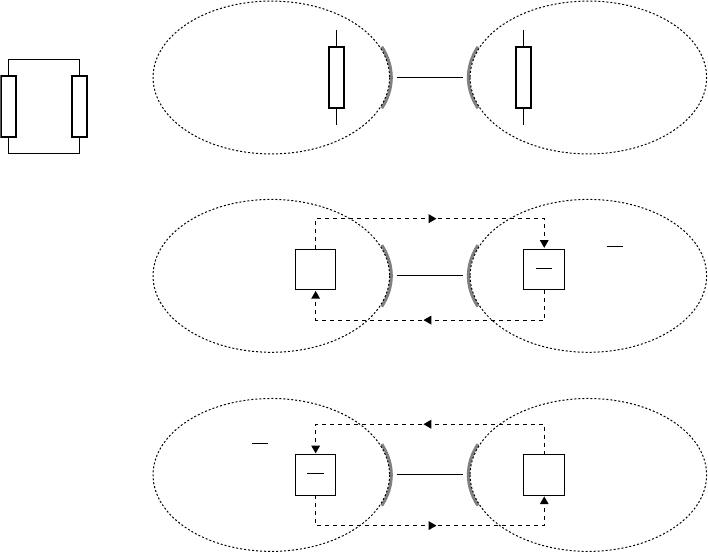
26-16 Handbook of Dynamic System Modeling
R
1
R
2
u ⫽ iR
1
u
u
i
i
u ⫽ iR
1
u ⫽ iR
2
Resistor R
1
1
u ⫽ iR
2
P ⫽ ui
P ⫽ ui
P ⫽ ui
i ⫽
Resistor R
2
Resistor R
1
Resistor R
2
Resistor R
1
Resistor R
2
R
1
R
2
R
2
1
R
1
u
R
2
i ⫽
u
R
1
(a) (b)
(c)
(d)
FIGURE 26.11 Arbitrary causality of two resistors causing an algebraic loop.
Arbitrary Causality
The expected next possibility in the sequence is that the causality of a port is neither fixed nor preferred,
thus arbitrary. Examples of arbitrary port causality are linear, resistive ports that are consequently invertible
and algebraic, respectively. The acausal form of the constitutive relation of an ohmic resistor is u −Ri =0,
the effort-out causal form is u =Ri, while the flow-out causal form is i =u/R (cf., Figure 26.11).
Causal Constraints
Causal constraints only exist for basic multiports, i.e., elements with two or more ports like the transducers
(TF, GY) and the junctions (0, 1). For instance, if the constitutive relation of the two-port transducers is
linear (the junctions are intrinsically linear), the first port to which causality is assigned is arbitrary, but
the causality of the second port is immediately fixed. For instance, the two-port transformer always has
one port with effort-out causality and one with flow-out causality. In contrast, the causalities of the ports
of a two-port gyrator always have the same type of causality. In graphical terms: a TF has only one causal
stroke directed to it, while a GY has either both causal strokes directed to it or none.
The fundamental feature of the junctions that either all efforts are common (0) or all flows are common
(1) shows that only one port of a 0-junction can have “effort-in causality,” i.e., flow-out causality, viz.
the result of its flow-balance. In contrast, only one port of a 1-junction can have “flow-in causality,” i.e.,
effort-out causality, viz. the result of its effort-balance. In graphical terms, only one causal stroke can be
directed toward a 0-junction, while only one open end can be directed toward a 1-junction.
26.3.3.2 Causal Analysis: Feedback on Modeling Decisions
Causal analysis, also called causality assignment or causal augmentation, is the algorithmic process of
putting the causal strokes at the bonds on the basis of the causal port properties induced by the nature
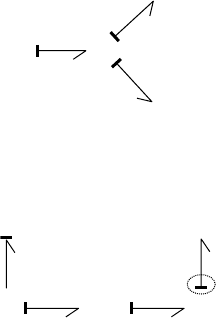
Port-Based Modeling of Engineering Systems in Terms of Bond Graphs 26-17
Port 2
Port 1
Sf 1
FIGURE 26.12 Propagation of a fixed causality via a 1-junction.
11TF
!
II
FIGURE 26.13 Dependent inertias via de causal constraints of 1-junctions and transformer.
of the constitutive relations. Not only the final result, but also the assignment process itself provides
immediate feedback on modeling decisions.
Fixed Causality of the First Kind
The first step is to assign fixed causalities of the first kind and immediately propagate them via the causal
constraints, as the latter cannot be violated. For instance, if a flow source is connected to a 1-junction,
the source-port flow-out causality by definition, which in turn means that the corresponding port at the
1-junction gets flow-in causality, which means that all other ports of the 1-junction get flow-out causality
(Figure 26.12), unless one can apply numerical iteration to impose the same flow at the junction from
more than one of its ports, but this is not anticipated in regular causal analysis that is focused on feedback
nor is it possible if only sources are involved. Conflicts between fixed causalities of the first kind via the
constraints indicate that the problem is ill-posed, e.g., two voltage sources in parallel or two force sources
trying to impose a different value to the same force. The causality propagation may lead to violation
of preferred causalities, e.g., a voltage source in parallel to a capacitor or a velocity source on a mass.
This violation feeds back to the modeler that no independent state is related to the storage element as its
content is imposed by a source, which also means that it is dynamically inactive as its rate of change will
only influence the source, which is insensitive to it by definition. Not only storage ports, but also resistive
ports that get their causality imposed by a source are dynamically inactive, as they cannot form signal
loops (so-called causal paths) via other ports. A causal path can be found to be following either a causal
stroke or an open end from one R-, C-, or I-type port to another. At a GY the causality reverses, so if one
follows the stroke one should continue with the open end or vice versa.
The adjective “dynamically inactive” does not mean that the port-variables cannot change, but that the
port does not contribute to the dynamic characteristics (like time constants and eigen frequencies) of the
system, which will become more clear after the discussion of preferred causality below. Conflicts with fixed
causalities of the second kind inform the modeler that the model has to be changed in such a way that
either the constitutive relation is changed such that it can be inverted or the structure is changed such that
the conflict disappears. If this is impossible, numerical iteration has to be applied to solve the noninvertible
relation.
Preferred Causality
After the assignment of all fixed causalities of the first kind, the preferred causalities are similarly assigned
and immediately propagated via the causal constraints. Conflicts at this stage indicate that a port may get
differential causality as a result of another port getting preferred integral causality. Figure 26.13 shows the
bond graph of two rigidly linked inertias, e.g., the motor inertia and the load inertia in a servo system

26-18 Handbook of Dynamic System Modeling
01TF TF1
IIC
FIGURE 26.14 Independent inertias by adding the elasticity of the transmission (e.g., belt-drive).
model, including a transmission (TF), but without any compliance. The causality of this bond graph shows
the modeler that he has chosen a model in which two storage ports depend on each other and form a
signal loop (causal path) with an integration that is compensated by a differentiation, i.e., a net algebraic
loop. The computational problem may be solved by
•
the application of implicit numerical integration,
•
changing the model (the sequence of putting the causal strokes hints the modeler where a model
change should be made, e.g., adding the compliance of the transmission between the two rigid bodies
(see Figure [26.14]), or
•
symbolic manipulation (either manually or automatically) of the model.
Preferred integral causalities that impose other preferred integral causalities give immediate feedback on
the existence of second-order signal loops by identifying the causal paths in the bond graph, i.e., loops
containing two integrations that lead to behavior as described by second-order differential equations, viz.
potentially oscillatory behavior. A similar kind of feedback on the dynamic properties of the model is
obtained by a port with arbitrary causality that is assigned its causality via propagation of an integral
causality. The resulting first-order causal path informs the modeler about relaxation type of behavior.
Finally, if a preferred causality creates a conflict with a fixed causality of the second kind, then the source
of the fixation has to be reconsidered and the problem solved by either changing the constitutive relation
or the model structure or by implementing numerical iteration.
Fixed Causality of the Second Kind
As discussed above, fixed causalities of the first kind and preferred causalities are given a higher priority
than fixed causalities of the second kind, unless a physical meaning can be assigned to the noninvertibility,
in which case the model needs reconsideration in the sense that the model becomes ill-posed or that the
number of free-to-choose initial conditions may be reduced. Accordingly, fixed causalities of the second
kind can only propagate to ports with arbitrary causality. In that case, mostly an algebraic loop will occur
and, if not solved symbolically beforehand, this requires numerical iteration during simulation too. This
shows that an explicit ODE model can only be obtained if fixed causalities of the second kind obtain
their proper causalities via propagation of fixed causalities of the first kind and preferred causalities. The
modeler should consider adapting the model if this is not the case.
Arbitrary Causality
Commonly all ports in a bond graph are causal after assigning and propagating fixed and preferred
causalities, but if this is not the case, it means that at least two ports with arbitrary causality are present.
If an arbitrary choice is made for one of these ports, this means that at least one other port will obtain its
causality as a result of propagation via the causal constraints (cf., Figure 26.11). The dual choice would have
the same effect. This shows the modeler that this situation always results in an algebraic loop (or its reverse
form corresponding to the dual choice of causality) that requires numerical iteration during simulation.
Similar to other causal conflicts, e.g., generated by differential causality, the assignment procedure itself
hints the modeler how to change the model to prevent the algebraic loop. The causality assignment process
is completely algorithmic and more advanced variations on this algorithm exist and are implemented that
can handle all possible situations in an automated way (van Dijk and Breedveld, 1991; Golo, 2002). As a
result, it can be used without using the notation itself, e.g., by replacing the bond graph with the more
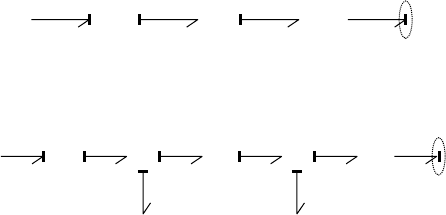
Port-Based Modeling of Engineering Systems in Terms of Bond Graphs 26-19
common iconic diagram representation or the linear graph notation. However, this largely reduces the
amount of feedback that can be given to the modeler about his modeling decisions and the effect of model
modifications becomes less obvious. Nevertheless, if one is merely interested in converting simple iconic
diagrams into code ready for simulation, this is a powerful option.
The support offered by causal analysis in the common trade-off between conceptual and computational
complexity of a model is illustrated by the simple example of a rigid constraint between two rigid bodies.
Conceptual simplicity leads to a causal problem (a so-called dependent inertia with differential causality)
and consequently to numerical complexity. The example in Figure 26.13 already showed that a loop
emerges containing an integration and a differentiation that cancel each other, i.e., a “net” algebraic loop,
similar to the situation where two resistors form such an algebraic loop (Figure 26.11). Direct equation
generation does not generate a set of ordinary differential equations (ODE), but a mixed set of differential
and algebraic equations (DAE). A set of DAE cannot be solved straightforwardly by means of explicit
numerical integration (e.g., with the common Runge–Kutta fourth-order method). However, the way in
which the causal problem emerges in the model during causal analysis of the bond graph clearly suggests
how the model can be modified to prevent the causal problem. In this example, the rigid constraint can be
replaced by an elastic element, i.e., a finite rigidity. Although this gives the model some more conceptual
complexity, the numerical (structural) complexity is reduced due to the fact that the resulting equations
are a set of ODE that can be solved by explicit numerical integration schemes (Ascher and Petzold, 1998).
The resulting model needs a rather stiff constraint and thus introduces dynamics at a timescale that is
not of interest. This not only means that both options to formulate the model can be a solution depending
on the problem context, the available tools, etc., but also that a third solution can be obtained, viz. a
symbolic transformation of the model as to eliminate the dependent inertia. In other words, two rigidly
connected rigid bodies may be considered as one rigid body. This possibility is directly induced by the
causal analysis of the bond graph model.
Example of Causal Analysis
If causality analysis is applied to the bond graph in Figure 26.7, the fixed causality of the Se propagates all
the way through the graph via the causal constraints of the two-ports and imposes differential causality
on the storage element (Figure 26.15).
It shows that the state of the system is imposed by the source, which means that the model cannot be
used to capture any physical behavior. At best, it may serve to analyze a stationary situation, although it is
not likely in a practical situation that none of the components has any losses. This immediate feedback on
modeling decisions is obtained without writing any equation. If dynamic behavior is to be captured, one
needs to modify the graph in such a way that it contains at least one independent state, e.g., the content of
the water tank. To that end it will need to have integral causality. For instance, if one would decide that the
friction in the bearings in the mechanical part should be modeled, the causal graph immediately shows
that this does not change the causality of the storage element (Figure 26.16).
Se CGY TF GY
u
i
T
v
T
v
p
w
!
FIGURE 26.15 Causally augmented initial bond graph of the pump system: no dynamics.
Se GY 1 1
RR
CTF GY
u
i
T
v
T
v
p
w
!
FIGURE 26.16 Addition of friction to the pump model: still no dynamics.
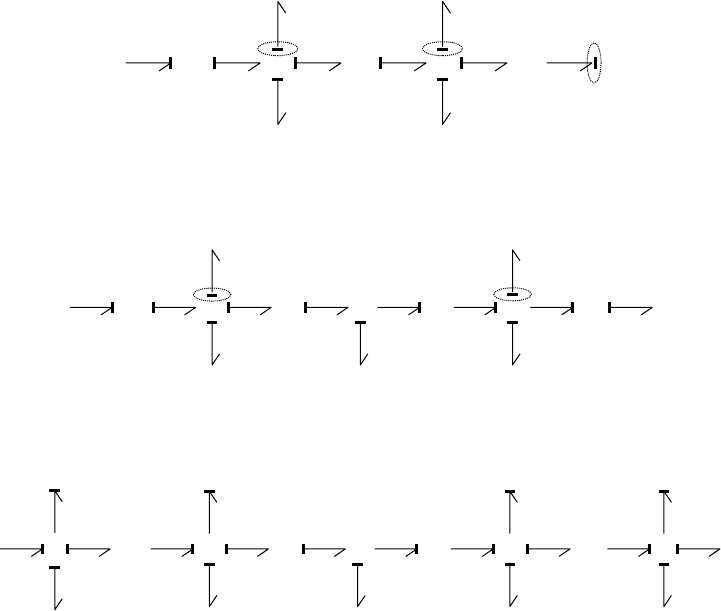
26-20 Handbook of Dynamic System Modeling
Se GY 1 1
RR
II
CTF GY
u
i
T
v
T
v
p
w
!
!
!
FIGURE 26.17 Addition of inertias to the pump model: still no dynamics.
Se GY 1 1
R
CR
II
C0TF TF GY
u
i
T
v
T
v
F
v
p
w
!!
FIGURE 26.18 Addition of inertias to the pump model: some dynamics, but not the expected dominant behavior.
R
I
1
u
i
GYSe 1 1
R
CR
II
R
I
0TF TF GY C1
T
v
T
v
F
v
p
w
FIGURE 26.19 Addition of motor inductance and fluid inertia solves the causal conflicts: ample dynamics.
The same holds for adding the inertias of the rotating parts (Figure 26.17). The differential causality of
the I-ports demonstrates that the imposed voltage not only imposes the hydraulic pressure, but also all
velocities.
The bond graphs shows that the only way to “break” the causal propagation between voltage source,
velocities, and pressure is to add a junction that breaks the causal path. This can be either a 0-junction in
the mechanical connections, i.e., allowing some relative speed or a nonstiff connection, or a 1-junction
in the electrical or hydraulic domain, i.e., allowing a voltage difference between source and motor or a
pressure difference between pump and tank. For instance, if the transmission is a belt drive, the elasticity
of the belt can be modeled (Figure 26.18).
However, this only gives the tank and the belt independent states: the two Cs form a second-order loop
via the GY-action of the pump. Furthermore, it forms a first-order loop (causal path via this GY with the
mechanical R at the right-hand side. The first inertia still gets its velocity imposed by the source, while the
state of the second depends on the state of the tank. The only way the resolve the first dependency is to
addanelectric1-junction connected to the resistance or the inductance of the current loop. Similarly, the
second dependency can be resolved by adding a hydraulic 1-junction connected to the resistance or the
inertia of the hydraulic line (Figure 26.19).
The process of eliminating all dependencies resulted in a relatively high-order system, viz. a sixth-order
system (4 × I, 2 ×C). If we assume for instance at this point that the elasticity of the belt can be neglected
after all, the two mechanical Is become dependent again, but these can be symbolically combined into one.
If the hydraulic lines are relatively short, the hydraulic I can be omitted too (Figure 26.20), such that a
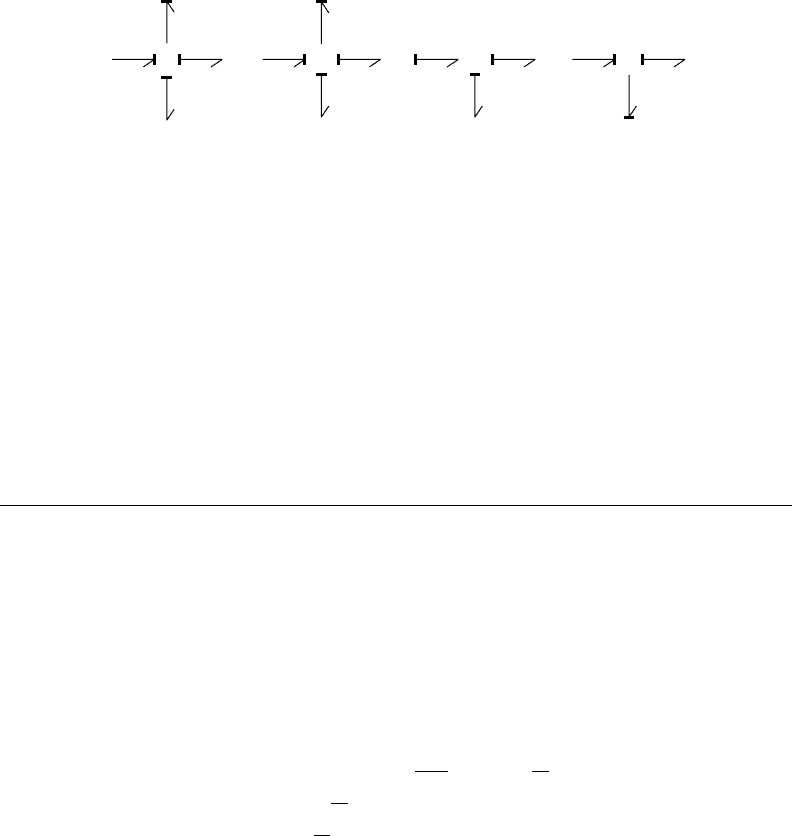
Port-Based Modeling of Engineering Systems in Terms of Bond Graphs 26-21
R
I
1
u
i
GYSe 1 1
RR
I
R
TF
..
n
GY C1
T
v
T
v
p
w
I
left
+ I
right
*n
2
FIGURE 26.20 Simplification of the model by symbolic manipulation and maintaining key behavior.
third-order model (2 ×I, 1 ×C) remains to capture the observed dynamics. Further modeling iterations
require a more detailed study of problem context and measurement data.
The above example demonstrates that it is possible to make far-reaching modeling decisions quickly,
because no detailed equations have to be written yet. Causality assignment thus proves to be not only a
means to create a model in a form ready for numerical simulation, but also provides direct feedback on
modeling decisions. The nine basic elements can be used to model many different dynamic problems.
However, in the next section it will be shown how the generalization of the basic elements can lead to even
more powerful modeling concepts.
26.4 Multiport Generalizations
All basic elements can be generalized to a multiport form and put into a multibond notation of which
the most important aspects are quite intuitive, cf., Figure 26.6 (Breedveld, 1985). Sources just form
arrays without any coupling owing to their nature, i.e., no relations between their conjugate variables.
Junctions already are arbitrary multiports. The multiport forms of the (modulated) TF and GY were
already introduced in Section 26.3.2.5. Herein, it is merely mentioned that position modulated multiport
transformers (MTF) are a powerful tool in modeling planar and spatial mechanisms (Tiernego and van
Dixhoorn, 1979; Bos and Tiernego, 1985; Bos, 1986; Stramigioli, 1998).
The generalization of a resistor, or rather the resistive port of an irreversible transducer, is also straight-
forward as it concerns an algebraic relation between the port variables. Assuming that the generic algebraic
form (e, f) =0, where e and f are the conjugate effort and flow vector of the resistive multiport can be
written e =e(f) (or f =f(e)) with variations de
i
=
j
∂e
i
(f)
∂f
j
df
j
,where
∂e
i
∂f
i
is the “self resistance” of the ith
port (diagonal element of the Jacobian) and
∂e
i
∂f
j
∀j =i are the nondiagonal coupling terms. If the Jacobian is
constant, the relations are linear e
i
=
j
∂e
i
∂f
j
f
j
=
j
B
ij
f
j
or e =Bf. In that case, the irreversibly produced
entropy flow f
S
irr
conjugate to temperature T can be written f
S
irr
=T
−1
e
t
f =T
−1
f
t
B
t
f, i.e., a quadratic
form in the flows. As only the symmetric part R =(B +B
t
)/2 of the constitutive matrix contributes to
the entropy production, only this part R is commonly considered to describe the resistive multiport. Its
symmetry corresponds to what is called Onsager symmetry or reciprocity in irreversible thermodynamics
(Callen, 1960), as the multiport R can be considered to represent a domain-independent form of descrip-
tion common in irreversible thermodynamics of the relations between generalized forces and fluxes. The
antisymmetric part G =(B −B
t
)/2 is readily identified as a power continuous multiport gyrator as intro-
duced already from another perspective in Section 26.3.2.5. It corresponds to Casimir’s extension of the
Onsager relations (Breedveld, 1982). Although it is quite interesting to see that this extension only occurs
between ports of domains that were identified earlier as having a symplectic interdomain coupling on
different grounds, further discussion goes beyond the scope of this treatise. Finally, it is noted that the
multiport resistor, just like the elementary one-port can be modulated without changing its fundamental
nature and that the symmetric matrix R has to be positive-definite where all diagonal elements have to be

26-22 Handbook of Dynamic System Modeling
positive as well as the determinants of all subblocks to satisfy the positive entropy production principle
at all times. Finally, only the multiport generalization of a storage element adds a new behavior, viz.
transduction. For this reason, multiport storage will be analyzed in more detail in the following section.
For all the multiports mentioned above (canonical), decompositions (Breedveld, 1984b) can be found
that not only enhance insight into the potential dynamic behavior of a model, but also allow recognition of
substructures as specific multiports (composition), of which an alternative decomposition may improve
numerical solution properties, as is the case for the well-known Euler junction structure (Karnopp and
Rosenberg, 1968; Breedveld, 1999).
26.4.1 Multiport Storage Elements
The generalization of a one-port storage element into an n-port storage element, where the ports may
belong to different domains, requires an approach based on the commonly conserved property, the energy.
It turns out that a new type of behavior will emerge from this extension, viz. transduction by a cycle
process. In other words, power can be transformed from one port to another and thus from one domain
into another by performing a cycle process with a multiport storage element with at least two ports. As
much of the literature is rather inaccurate about the use of the concept of energy, the distinction between
coenergies (often incorrectly considered energies when they have the same numerical value as the energy)
and the globally conserved energy will be made clear first by a discussion of Legendre transformations of
homogeneous functions.
26.4.1.1 Coenergy and Legendre Transforms
A concise overview of homogeneous functions and Legendre transforms is given and applied to energy
functions, thus introducing the concept of coenergy. Various properties of energy and coenergy related
to multiport storage are shortly discussed and related to a physical interpretation. Finally, some domain-
specific forms of coenergy are discussed.
Math Background: Homogeneous Functions and Euler’s Theorem
A function F(x
) with x =x
1
, ..., x
k
is homogeneous of order n if F(αx) =α
n
F(x). If y
i
(x) =∂F/∂x
i
,
then y
i
(αx) =∂F(αx)/∂αx
i
=
α
n
α
·∂F(x)/∂x
i
=α
n−1
y
i
(x), in other words, y
i
(x) is homogeneous of order
(n −1). For such homogeneous functions Euler’s theorem holds
k
i=1
∂F
∂x
i
·x
i
= n ·F(x)orF(x) =
1
n
k
i=1
y
i
·x
i
=
1
n
·y
T
·x (26.22)
By definition the variation of F can be written as
dF =
k
i=1
∂F
∂x
i
·dx
i
=
k
i=1
y
i
dx
i
= y
T
·dx (26.23)
but also using Eq. (26.22)
dF = d
1
n
y
T
·x
=
1
n
y
T
·dx +
1
n
(dy
)
T
·x (26.24)
Combination of Eq. (26.23) and Eq. (26.24) gives
(dy
)
T
·x = (n −1)y
T
·dx
and for n =1:(dy)
T
·x =0, for n =1:dF =
1
n −1
(dy)
T
·x.
Homogeneous Energy Functions
The energy of a system with k state variables q
is E(q) =E(q
1
, ..., q
k
). If q
i
is an “extensive” state
variable, this means that E(αq
) =αE(q) =α
1
E(q). Hence E(q)isfirst order (n =1) homogeneous, so
e
i
(q) =∂E/∂q
i
is zeroth order (n −1 =0) homogeneous, which means that e
i
(q) is an “intensive” variable,
i.e., e
i
(αq) =α
0
e
i
(q) =e
i
(q).
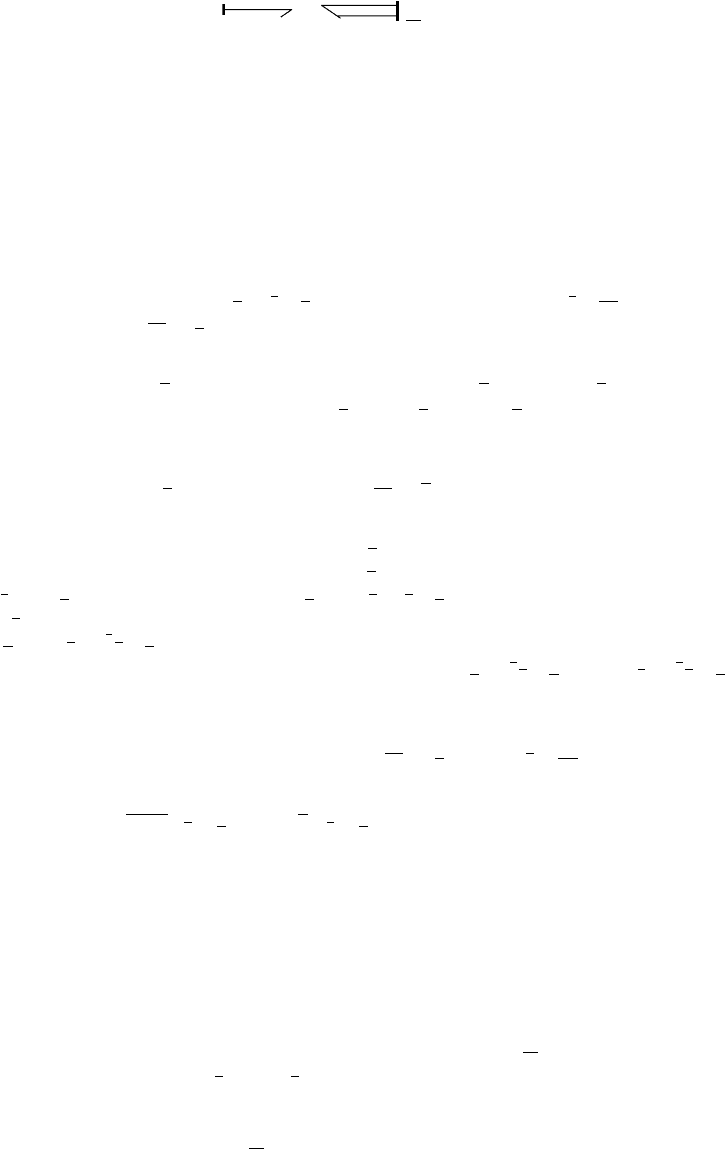
Port-Based Modeling of Engineering Systems in Terms of Bond Graphs 26-23
e
1
f
1
⺓
⺓
n⫺1
n⫺1
Sf:0
FIGURE 26.21 Bond graph of a “one-port storage element.”
This means also that in case n =1 and k =1 e(q) is constant, i.e., ∂e/∂q =de/dq =0, which changes the
behavior of this element into that of a source. This means that storage elements should in principle be mul-
tiports (k > 1). A one-port storage element is in principle an n −port storage element of which the flows
of n −1 ports are kept zero. Accordingly, the corresponding n −1 states are constant and commonly not
recognized as states. Such states are often considered parameters: if E(q
1
, q
2
, ..., q
n
)|
dq
i
=0,∀i=1
=E
(q
1
),
then E
(q
1
) not necessarily first-order homogeneous in q
1
(cf., Figure 26.21).
For n =1 and k independent extensities there are only k −1 independent intensities, because for n =1
we find Gibbs’ fundamental relation: E(q
) =e
T
·q. As by definition holds that dE =e
T
·dq
, this results in
the Gibbs–Duhem relation:(de
)
T
·q =0, which expresses that one of the intensities depends on the others.
Math Background: Legendre Transforms
A Legendre transform L of F(x) with respect to x
i
is by definition L{F(x)}
x
i
=L
x
i
=F(x) −y
i
·x
i
,where
y
i
=∂F/∂x
i
and the total Legendre transform of F(x)isL{F(x
)}=L =F(x) −
k
i=1
y
i
x
i
. Eq. (26.22)
shows that L =0 for n =1. Now dL
x
i
=dF −d(y
i
x
i
) =dF −y
i
dx
i
−x
i
dy
i
=
j=i
y
j
dx
j
−x
i
dy
i
or
L
x
i
=L
x
i
(x
1
, ..., x
i−1
, y
i
, x
i+1
, ..., x
k
), which means that x
i
is replaced by y
i
as independent variable
or “coordinate!” Hence L =L(y
); dL =−
k
i=1
x
i
dy
i
=−(dy)
T
·x.
Coenergy Functions
The complimentary energy or coenergy E
∗
q
i
of E(q)ofwith respect to q
i
is by definition:
E
∗
q
i
=−L
q
i
=E
∗
q
i
(q
1
, ..., q
i−1
, e
i
, q
i+1
, ..., q
k
). Hence E(q) +E
∗
q
i
(..., e
i
, ...) =e
i
·q
i
. For the total coen-
ergy E
∗
(e)ofE(q) holds that E
∗
=−L,henceE(q) +E
∗
(e) =e
T
·q, which explains the terminology. For
n =1: E
∗
(e) =0, confirming the earlier conclusion that there are only k −1 independent intensities e
i
.For
n =2: E(q
) =E
∗
(e) =
1
2
e
T
·q (i.e., equal in value, but different in nature as is the case for linear constitutive
relations that result in quadratic energy functions!) and for n =3: E(q
) =
1
3
e
T
·q while E
∗
(e) =
2
3
e
T
·q.
The following relations for coenergy functions can be useful:
dE
∗
q
i
= de
i
·q
i
−
j=1
e
j
·dq
j
dE
∗
=
k
i=1
de
i
·q
i
= (de)
T
·q = (n −1)e
T
·dq = (n − 1)dE
E
∗
= (n −1)E =
n −1
n
·e
T
·q =
1 −
1
n
e
T
·q.
Next, several domain dependent manifestations of the Legendre transforms will be discussed.
Legendre Transforms in Thermodynamics
In thermodynamic systems of “simple” systems with internal energy U that is a function of the extensities
entropy S, volume V, total mole number N, and mole number per species iN
i
, the conjugate intensities
are temperature T =∂U/∂S, pressure p =∂U/−∂V =−∂U/∂V (energy increases in case of compression
−∂V , total material potential µ
tot
=∂U/∂N, and chemical potential µ
i
=∂U/∂N
i
, respectively. The Leg-
endre transforms are the free energy F, the enthalpy H, and the Gibbs free enthalpy G.Thefree energy F is a
Legendre transform of the energy with respect to the entropy S: L
S
=F(T, V, N
, N) =U −TS =, −pV +
m−1
i=1
µ
i
N
i
+ µ
tot
·N (=N ·f (T, v, c)) where c, is the vector of molar fractions and with variation dF =
−SdT −pdV +
m−1
i=1
µ
i
dN
i
+µ
tot
·dN, which means that the thermal domain does not influence the
free energy at constant temperature. The enthalpy H is a Legendre transform of the energy with respect
to the available volume V: L
V
=H(S, p, N, N) =U −(−pV ) =U +pV (=N ·h(s, p, c)) with variation
dH =TdS +V dp +
m−1
i=1
µ
i
·dN
i
+µ
tot
·dN, which means that the mechanical domain does not influ-
ence the enthalpy at constant pressure. Finally, the Gibbs free enthalpy G is a Legendre transform of the

26-24 Handbook of Dynamic System Modeling
energy with respect to both the entropy S and the available volume V: L
S,V
=G(T, p, N, N) =U −TS −
(−pV) =µ
tot
·N +
m−1
i=1
µ
i
N
i
(=N ·g(T, p, c)) with variation dG =−SdT +V dp +
m−1
i=1
µ
i
dN
i
+
µ
tot
·dN, which means that both the mechanical domain and the thermal domain do not influence
the Gibbs free enthalpy at constant pressure and temperature. For one constituent (m =1) it holds
that g =µ
tot
(T, p), which means that the equilibrium of the material is determined by pressure and
temperature.
Legendre Transforms in Mechanics
In mechanical systems with kinetic energy T and potential energy V, i.e., of which the total
energy is the Hamiltonian H that is a function of the extensities displacements vector x
and the
momenta vector p
: E(q
) =H(x, p) =T +V, while the conjugate intensities are the velocities vector
v
=∂H/∂p
and the vector of forces F =∂H/∂x, respectively. The Legendre transforms of the Hamilto-
nian H are the Lagrangian L, the co-Hamiltonian and the co-Lagrangian or Hertzian.TheLagrangian
L is a negative Legendre transform (coenergy) of the Hamiltonian with respect to the momenta
p
: H
∗
p
=−L
p
=v
T
·p
−H =(T +T
∗
) −(T +V ) =T
∗
−V =L(x, v), the co-Hamiltonian is a negative
Legendre transform (coenergy) of the Hamiltonian with respect to both the displacements x
and the
momenta p
: H
∗
x
,p
=v
T
·p
+F
T
·q −H =(T +T
∗
) +(V +V
∗
) −(T +V ) =T
∗
+V
∗
=H
∗
(F, v) and the
co-Lagrangian or Hertzian is a negative Legendre transform (coenergy) of the Hamiltonian with respect to
the displacements x
: H
∗
x
=F
T
·q
−H =(V +V
∗
) −(T +V ) =V
∗
−T =−L
∗
(F, p).
Note that adding the symplectic coupling between the kinetic and potential domains leads to the
common Hamiltonian formulation of the equations of motion, where J is the symplectic matrix:
d
dt
q
p
=
0 +1
−10
⎡
⎢
⎢
⎣
∂H
∂q
∂H
∂p
⎤
⎥
⎥
⎦
+
0
F
external
= J
⎡
⎢
⎢
⎣
∂H
∂q
∂H
∂p
⎤
⎥
⎥
⎦
(26.25)
while after the Legendre transform into the Lagrangian the equations of motion are written
d
dt
⎡
⎣
q
∂L
∂v
⎤
⎦
=
0 +1
−10
⎡
⎣
∂L
∂q
v
⎤
⎦
+
0
F
external
or, by eliminating
dq
dt
= v :
d
dt
∂L
∂v
+
∂L
∂q
= F
ext
Note that in both common formulations velocity sources are excluded.
Legendre Transforms in Electrical Circuits
In electrical circuits with capacitor charges q
and conjugate voltages u and coil flux linkages λ
and conjugate currents i
, the total stored energy is E(q, λ) =E
C
(q) +E
L
(λ). The total coenergy is
E
∗
(u, i) =u
T
·q +i
T
· −E =E. Note that the last equal sign only holds in case of circuit elements
with linear constitutive relations. Nevertheless, this assumption is seldom made explicit when coenergy is
used as the “energy” of an electric circuit.
Legendre Transforms and Causality
The above similarities between the Legendre transforms in these different domains are often not made
explicit. For instance, some properties of and processes with multiports that are quite common in ther-
modynamics are not common in mechanics and electrical circuit theory, although they may be used to
enhance insight in similar ways.
In the domain independent approach as denoted in bond graphs one can conclude that if an effort
is “forced” on a port of a C-element (“derivative causality” or “flow-out causality”), this means that
the roles of e and q are interchanged in the set of independent variables, which means that the energy
has to be Legendre transformed to maintain a generating function for the constitutive relations. Such a
transformation is particularly useful when the effort e is constant. For example, an electrical capacitor in an
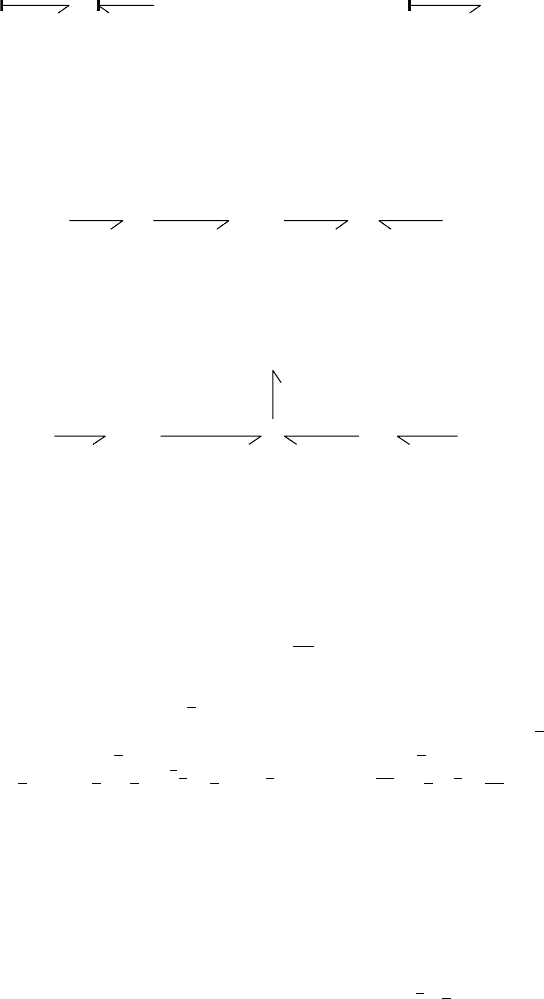
Port-Based Modeling of Engineering Systems in Terms of Bond Graphs 26-25
u
q
L
s
⫽ F(q,T) ⫽ E⫺TS dF ⫽ udq⫺SdT ⫽ ud
q
.
S
T
.
⺓
⺓
Se:T
const
becomes
u
q
.
C
FIGURE 26.22 Use of free energy at constant temperature: no thermal port required.
uF⫽⫺F⬘F⬘nBlv
nBl
ii vv
11GY
..
FIGURE 26.23 Basic transduction in a loudspeaker.
u
i
ii
i
F
V
SGY 0 TF
C : L
..
nBl
⫺nBlv
dLi/dt
dl/dt
FIGURE 26.24 Addition of magnetic storage with an explicit magnetic domain.
isothermal environment with T =T
const
can be characterized by the free energy: dF =udq −SdT =udq
and the thermal port can be omitted as it does not result in changes of the free energy F (Figure 26.22):
P = u ·˙q =
dF
dt
(26.26)
Independent of the domain the function e
i
(q) that characterizes a storage port is called constitutive relation
or constitutive equation, constitutive law, state equation, and characteristic equation.Ife
i
(q
)islinear, i.e.,
first-order homogeneous, then E(q
) is second-order homogeneous, i.e., E(q
)isquadratic. In this case, and
only in this case: E(αq
) =α
2
E(q) E(q) =
1
2
e
T
·q =E
∗
(e) and dE
∗
=(de)
T
·q =e
T
·dq =dE, i.e., the value
of energy and coenergy are equal.
Another property of constitutive relationsof storage elements that is commonlyused in thermodynamics
is Maxwell reciprocity or Maxwell symmetry. From the principle of energy conservation can be derived
that the mixed second derivatives of the energy should be equal ∂
2
E/∂q
i
∂q
j
=∂
2
E/∂q
j
∂q
i
. This means that
∂e
j
/∂q
i
=∂e
i
/∂q
j
, i.e., the Jacobian matrix of the constitutive relations is symmetric. Maxwell symmetry
requires the“true energy”form (integral causality) as Legendre transforms generally destroy the symmetry
of the Jacobian. Yet another property that is commonly used in thermodynamics (le Chatelier–Braun
principle) to check the intrinsic stability of a system that can be considered a multiport storage element
is that the Jacobian of and all its subblocks are also positive-definite: det (∂e
/∂q) > 0 and that the diagonal
elements of the Jacobian are positive: ∂e
i
/∂q
i
> 0 ∀i.
26.4.1.2 Loudspeaker Example
The dominant behavior of a loudspeaker, in particular the electromechanical transduction based on the
Lorentz force, F =n(i ×B)l and on dλ/dt =u =n(v ×B)l, can in the given configuration be approximated
byagyrator,F =(nBl)i and u =(nBl)v (Figure 26.23).
Making the relation between electric and magnetic domain explicit by means of an SGY shows that
the storage of magnetic energy in the voice coil can be represented by a magnetic C (Figure 26.24) for
